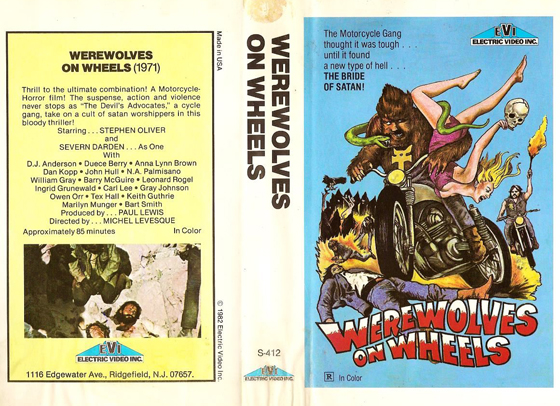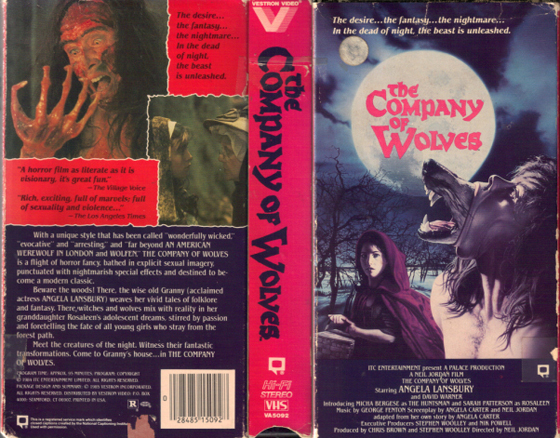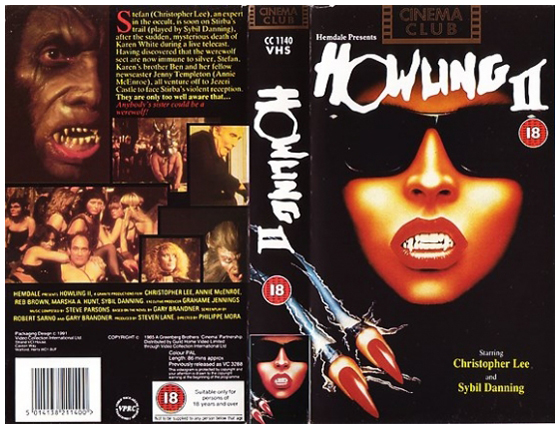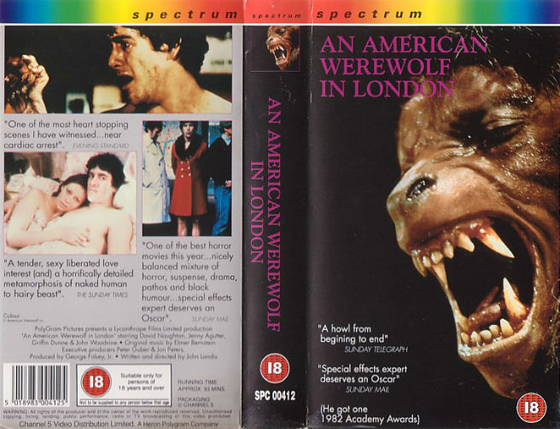 Werewolves
Werewolves
Exploitation Videos 7
published in Video Age, January 1986, MelbourneIf Dracula was the monster for the ‘70s (taking in everything from lesbianism to negroes to discos), then the Werewolf is definitely the monster for the '80s. The first half of this decade has witnessed The Howling, Wolfen, Full Moon High and An American Werewolf In London, not to mention video clips like Michael Jackson's Thriller and Ozzie Osbourne's Bark At The Moon. And those wolves keep on coming.
Just as Michael J. Fox's latest comedy Teen Wolf gets a theatrical release here in Australia, three werewolf movies find their way onto video: The Company Of Wolves (1985), The Howling II (1985) and Werewolves On Wheels (1971). Real exploitation films mix exploitative genres in an attempt to intensify their exploitation value. Hence: wrestlers with vampires, vigilantes with sci-fi, cowboys with drugs, sex with zombies, rock 'n' roll with gore, negroes with crime, and bikies with werewolves.
Werewolves On Wheels is one of the many films from the early ‘70s which capitalised on the Manson murders (I Drink Your Blood, The Deathmaster, Simon - King Of Witches, etc.) this time centring on a satanic sect who, after being disturbed by a bikie gang, turn them into werewolves. Don't ask me how or why, because this film has naught to do with reason and reality, but is instead fraught with raging and wretching. (How poetic!) Still, the cheap gore effects alone make Werewolves On Wheels a solid horn-blaster (drive-in hip talk for "very good movie").
If only the glossy The Company Of Wolves were not so dazzling in its beautiful composition, we might have had a half-decent horn-blaster. Unfortunately, this British production (and let's face it: the Poms are just as woeful as Australians when it comes to making a movie with balls) is so visually breathtaking, so arty and theatrical that when the gore bits pop-out, they are gratuitous in the fullest sense. The whole dream-within-a-dream form of narrative is tacky and tiresome, because whereas Nightmare On Elm Street utilises such a format purely for effect, The Company Of Wolves actually tries to do it meaningfully.
Okay, so this film is incredibly well-made (even though many reviewers failed to notice that its employment of Sherwood Studios marks it as being only half as inventive with the use of decor as the early Hammer horrors) but ultimately it waffles on and becomes seduced by its own beauty. Chris Tucker's makeup work (easily matching his sophisticated work on Quest For Fire and The Elephant Man) comes off better than the animatronics in the film, which at times resemble a Gerry Anderson puppet production. In short, the gore is good but the film is flab — the result of attempting to make a Clayton's horror movie: the horror movie you make when you're trying to deny that you're making a horror movie.
But the pick of the "were-wolves on video" this month has to be The Howling II. Now, it being a sequel, it should be pointed out that there is a right way and a wrong way to watching sequels. The wrong way is to compare the sequel to the original. That's as dumb as saying the book was better than the movie. Yuk! The sequel and the original are two separate movies, and the only reason they're called sequels is to cash in on the success of the original. If you go expecting something of the original you've been exploited, sucker! Never believe the advertising to any movie.
The right way to watch a sequel is to take for granted that there will be a few extraneous and superficial tie-ins with the original, but that's only to keep the backers happy so that they'll cough-up the money for the movie. Often the sequel can be a real exploitative gem, outshining the original either in terms of invention and action (like Amityville II: The Possession and Halloween III: Season Of The Witch) or by going so over the top you've got to hand it to them (like Pirahna II: Flying Killers and Exorcist II: The Heretic). The Howling II is totally different from Joe Dante's original, yet every bit as good.
The Howling II is directed by expatriate Australian director Phiiiipe Mora – and if you're asking who in hell he is, then you can't have seen the surprise horror film of 1982, The Beast Within. Scripted by Tom Holland (who among other things went on to direct Fright Night this year) and with special-effects makeup by Tom Burman (One Dark Night and Cat People), The Beast Within is everything a good exploitation horror film should be: flashy, cheap, gory, tacky, illogical, fast, humorous, bloody and crazy. Let's pray that it will soon get a video release because it is just as good as The Howling II and bounds ahead of Mora's other two releases on video, the quirky Mad Dog Morgan and the campy The Return Of Captain Invincible.
The Howling II stars Christopher Lee (still going strong) and horror queen Sybil Danning (last seen in the TV series V). The story is wildly and wonderfully illogical – which befits a 1985 werewolf movie. I mean, who cares now about all those monster rules when they can be broken to make crazy, fantastic plots? In Howling II, Marsha Hunt plays a negress werewolf who can control her transformations at will and is impervious to silver bullets. And the things that Sybil Danning does in her role of Stirba (looking like a Transylvanian S&M werewolf queen!) have certainly not appeared in any werewolf film I've ever seen. Look out, too, for the punk who gets his hand cut off, the priest who gets his tongue ripped out and the dwarf whose eyeballs explode!
If you're into being exploited by exquisiteness in classy European art-films, go for The Company Of Wolves. But if you're for exploitation at its most exquisite, go for The Howling II. (Oh, and if you're a hairy bikie ...)
Text © Philip Brophy 1986. Images © respective copyright holders




